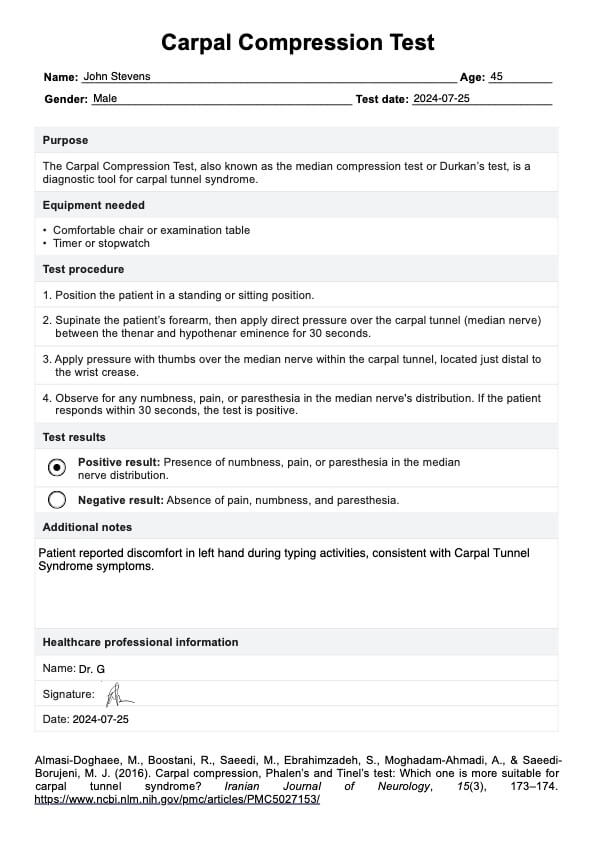Carpal Compression Test
Diagnose Carpal Tunnel Syndrome efficiently with our Carpal Compression Test template. Learn about symptoms, causes, and benefits for diagnosis and improved patient care.


What is carpal tunnel syndrome?
Carpal tunnel syndrome (CTS) is a condition that occurs when the median nerve, which runs from the forearm into the palm, becomes compressed at the wrist. This nerve controls sensations to the palm side of the thumb and fingers (except the little finger) and impulses to some small muscles in the hand that allow the fingers and thumb to move. When the median nerve is compressed, it can result in pain, numbness, and weakness in the hand and arm, significantly impacting daily activities.
Symptoms
Carpal tunnel syndrome often presents various symptoms affecting one or both hands. These symptoms include:
- Numbness or tingling in the thumb, index, middle, and ring fingers
- Pain in the wrist or hand that may radiate up the arm
- Weakness in the hand and difficulty holding objects
- A sensation of swelling in the fingers, even without visible swelling
- Increased discomfort at night or upon waking
Causes
Several factors can contribute to the development of carpal tunnel syndrome, including:
- Repetitive hand movements, especially those involving prolonged wrist flexion or extension
- Wrist injuries, such as sprains or fractures
- Conditions like diabetes, rheumatoid arthritis, and thyroid dysfunction
- Pregnancy, due to fluid retention
- Obesity
- Genetic predisposition (smaller carpal tunnel in some individuals)
Carpal Compression Test Template
Carpal Compression Test Example
What is the Carpal Compression Test?
The Carpal Compression Test, also known as the median compression test or Durkan’s test, is a new diagnostic test used to identify carpal tunnel syndrome. This test involves applying direct pressure over the carpal tunnel, specifically on the median nerve, to elicit symptoms of numbness, pain, or tingling in the hand. The test is simple to perform and requires no special equipment, making it a practical choice for both clinical and home settings.
In the Carpal Compression Test, the patient is either seated or standing, with their forearm supinated. The examiner applies pressure over the median nerve at the carpal tunnel, located just distal to the wrist crease, using their thumbs. This pressure is maintained for about 30 seconds. The reproduction of symptoms such as numbness, tingling, or pain in the median nerve distribution indicates a positive test.
Studies have shown that the Carpal Compression Test has higher sensitivity and specificity than other standard tests for carpal tunnel syndrome, such as Tinel’s Test and Phalen’s Test. The sensitivity and specificity of the Carpal Compression Test are 80.6% and 52.9%, respectively. Combining this test with Tinel’s Test increases the likelihood of a correct diagnosis (Almasi-Doghaee et al., 2016).
How to use our Carpal Compression Test template
Using our Carpal Compression Test template is straightforward and helps streamline the assessment process for diagnosis of carpal tunnel syndrome. Here’s how to use it effectively:
Step 1: Download the template
Start by downloading our Carpal Compression Test template from this page. This template will guide you through the test procedure and provide a structured format for recording results.
Step 2: Prepare the equipment
Ensure you have all necessary equipment, including the template, a comfortable chair or examination table, and a timer or stopwatch.
Step 3: Position the patient
Have the patient sit or stand with their forearm supinated. Ensure they are comfortable and relaxed.
Step 4: Perform the test
Apply direct pressure over the carpal tunnel using your thumbs, located just distal to the wrist crease, and maintain this pressure for 30 seconds. Observe and record any symptoms of numbness, pain, or tingling.
Step 5: Record the results
After applying pressure on the carpal tunnel, document the test results on the template, noting whether each hand tested positive or negative. A positive test indicates symptoms within 30 seconds of applied pressure.
Benefits of using our template
Our Carpal Compression Test template offers a structured and efficient way to test for carpal tunnel syndrome, with diagnostic accuracy and specificity, making the whole diagnostic test process seamless and practical. Here are three key benefits:
Streamlined process
Using our template ensures that you follow a consistent procedure every time, which helps maintain diagnostic accuracy and reliability in diagnosing carpal tunnel syndrome. The template guides you through clinical diagnosis step-by-step, reducing the chances of errors and omissions.
Comprehensive documentation
Our template provides a detailed format for recording the diagnostic test results performed, including the patient’s responses and time. This thorough documentation is essential for tracking patient progress and for future reference, making follow-up assessments more straightforward.
Improved efficiency
Healthcare professionals can use the template to conduct the Carpal Compression Test quickly and efficiently. The structured layout and clear instructions save time, allowing for more focused patient care and reducing the administrative burden.
Reference
Almasi-Doghaee, M., Boostani, R., Saeedi, M., Ebrahimzadeh, S., Moghadam-Ahmadi, A., & Saeedi-Borujeni, M. J. (2016). Carpal compression, Phalen’s and Tinel’s test: Which one is more suitable for carpal tunnel syndrome? Iranian Journal of Neurology, 15(3), 173–174. https://www.ncbi.nlm.nih.gov/pmc/articles/PMC5027153/
Commonly asked questions
The Carpal Compression Test involves applying direct pressure using the thumbs over the carpal tunnel for 30 seconds. A positive result is indicated by numbness, pain, or tingling.
Symptoms include numbness, tingling, and pain in the thumb, index, middle, and ring fingers. Patients may also experience hand weakness and difficulty holding objects.
The compression of the median nerve in the wrist causes it. Factors include repetitive hand movements, wrist injuries, certain medical conditions, and pregnancy.
Treatment options include wrist splinting, anti-inflammatory medications, corticosteroid injections, and, in severe cases, surgery to relieve pressure on the median nerve.
Prevention strategies include taking regular breaks from repetitive tasks, maintaining a neutral wrist position, and performing hand and wrist exercises to reduce strain.







































































































